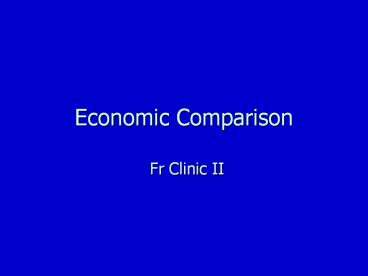Economic%20Comparison
Title:
Economic%20Comparison
Description:
Economic Comparison Fr Clinic II –
Number of Views:136
Avg rating:3.0/5.0
Title: Economic%20Comparison
1
Economic Comparison
- Fr Clinic II
2
Overview
- Economics and Engineers
- Time Value of Money
- Different types of Economic Analyses
- Comparing our filters two examples
3
Warning
- The field of economic comparison is huge, Ive
left a lot out.
4
Engineers and Economics
- Engineers often must estimate the benefits and/or
costs of their designs - Buildings, roads, landfills
- New products
- Communication systems
- Refineries, oil platforms
5
Time Value of Money
- What would you rather have, 100 now or 5 years
from now? Why? - Assuming you dont need the 100 to meet some
immediate need, what is your answer? Why?
6
Investments
- You can take that 100 and invest it in bank
accounts, bonds, or stocks and get a return on
your investment - At a 10 annual return,
- what will 100 be worth in five years?
- 100 (1.1)(1.1)(1.1)(1.1)(1.1) 100 (1.1)5
161 - getting the 100 five years from now would be the
same as getting what amount now? - 100 (1.1)-5 62
7
Different types of Economic Analyses
- Present Worth
- Transform costs and benefits into equivalent
present value - Project with largest present worth is best
- Annual Cash Flow
- Transform costs and benefits into equivalent
uniform annual amounts over project lifetime - Project with largest annual net benefit is best
8
Different types (Cont.)
- Payback Period
- How long will it take for an investment (say a
new manufacturing process) to recover its cost? - Projects with short payback period are good, but
direct comparison of projects requires an
incremental process - Benefit/Cost Ratio
- Determine ratio of benefits to costs, see if its
gt than 1 - High B/C ratios are good, but direct comparison
of projects requires an incremental method - Rate of Return
- Determine the rate of return provided by a
project (similar to the interest rate for a bank
account) - High rate of return is good, but direct
comparison of projects requires an incremental
process
9
What if all you have are costs?
- If its difficult to assign monetary value to
benefits, you may be left with only costs - Can still use present worth and annual net
benefit methods - Just look for alternative with the smallest
present or annual cost - This assumes alternatives provide similar benefits
10
Comparing Filters
- Without time value of money
- Costs are purchase of (a) entire unit and (b)
replacement cartridges - Costs can be related to volume of water treated
- With time value of money
- Must estimate rate at which water will be
treated, to estimate cartridge replacement times
11
Without time value, example 1
- Filter 1
- Initial cost 40, replacement filter 30, every
100 Liters - Filter 2
- Initial cost 60, replacement filter 20, every
100 Liters - Filter 3
- Initial cost 80, replacement filter 60, every
500 Liters
12
Excel Calculations, example 1
Cumulative Expenditures
13
Figure, example 1
14
With time value, example 2
- Same as first example, but take into account time
value of money. - Need to determine when costs occur, then
transform to equivalent present costs. - PC FC (1 i)-n
- PC present cost
- FC future cost
- i annual interest rate
- n number of years
15
Additional information, example 2
- Lifetime and salvage cost of Filters
- 10 year lifetime and 0 salvage cost
- Interest rate? ? 8 (i 0.08 in equation)
- When do you buy replacements?
- Buy replacements at beginning of year needed
(i.e., end of previous year) - How much water do people drink per day of filter
use? - 2 L/day
16
Additional Information, example 2
- Lets conduct three different comparisons, for
three levels of use. - Low 12 people-days/year (24 L/yr)
- e.g., three 2-people, 2-day outings
- Moderate 48 people-days/year (96 L/yr)
- e.g., twelve 2-people, 2-day outings
- High 144 people-days/year (288 L/yr)
- e.g., twenty-four 3-people, 2-day outings
17
Calculations, example 2
PC for filter 1, Low use scenario 40 30
(1.08)-4 30(1.08)-8 PC for Filter 1, Mod use
scenario 40 30(1.08-1) 30(1.08-2)
30(1.08-8) 30(1.08-9)
18
Present Worth Figure
19
Conclusion
- Conduct an economic comparison of the filters
using the methods outlined here!































